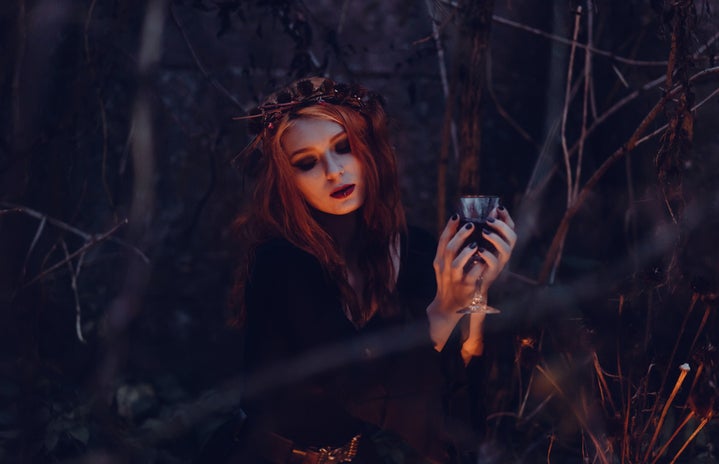The Salem Witch Trials are a tragic historical event. They are known as a period of hysteria and injustice, fueled by religious fears. Nowadays, the delirium is considered interesting purely for the eerie details. The trials are heavily associated with Halloween and the site of these trials has become a tourist hotspot, especially during autumn. Enthusiasts flock to Salem, Massachusetts to visit museums, go on ghost tours, and participate in live reenactments of the witchcraft examinations. As for the trials themselves, they are now deemed a grand mistake because spoiler alert: they weren’t actually witches. What many people fail to realize is how the trials and deaths of these “witches” were a product of fear and resentment toward women who opposed societal norms at the time.
The accusations began in early 1692 in Salem, Massachusetts and lasted until mid-1693. In less than two years, over 200 people were accused of practicing witchcraft, and 25 of them died for it. At the time, the accusations were made from a mostly religious standpoint. Salem mainly consisted of Puritans who, according to Emerson W. Baker, professor of history at Salem State University, “were pretty intolerant.” Baker described Salem as a “religious colony.” The Puritans built a “God-fearing, patriarchal society […] determined to preserve its way of life and belief system at any cost.” Clearly, religious beliefs were highly valued to Salem residents and in turn, were protected by any means necessary. According to Kristen J. Solleé, writer and educator, anything that “didn’t align with prevailing Christian doctrine could be deemed satanic.” While there was no witchcraft involved in this situation, anything that went against societal norms was deemed the work of the devil. When people were being accused of witchcraft, which was considered a severe affront to their beliefs and a direct connection to the devil, Puritans would go to great lengths to rid the town of witches.
The first accusation of witchcraft in Salem came from Elizabeth, the daughter of Reverend Samuel Parris, and his niece, Abigail, who were nine and eleven years old at the time. They exhibited symptoms of “convulsing, barking, and speaking unintelligible words.” The girls later accused Parris’ slave, Tituba, for being the cause of their symptoms. Tituba confessed to the crime while “under pressure for her life.” Her confession launched a “full-blown witchcraft crisis in Salem.” Paranoia and hysteria immediately spread throughout Salem and terrified many. The following months consisted of over 200 accusations of witchcraft and resulting imprisonments. The victims were typically hanged, tortured, or died while in prison.
In the year 1702, ten years following the beginning of the trials, the Massachusetts’ General Court declared the Salem Witch Trials unlawful. In 1711, the colony of Massachusetts passed a bill “restoring the rights and good names of many of the accused” as well as restitution to the heirs. It took over 250 years for Massachusetts to formally apologize for the Trials and all that occurred. Elizabeth Johnson Jr., one of the convicted, was not exonerated, possibly due to not being hanged and having no descendants. Her conviction remained until July of last year. It took 329 years for the entirety of the victims to be exonerated from their false convictions.
Women at the time of the trials were seen as lesser beings. Baker explains that according to biblical doctrine, “women were seen […] as weaker vessels and […] more susceptible to evil and Satan’s wiles.” They were believed to be inferior to men and the society of Salem was based entirely on a patriarchal ideology. Furthermore, most of the women who were accused were older and post-reproductive. According to Lynn Stuart Parramore, “in patriarchal societies […] post-reproductive women have often been scapegoated as threats and burdens.” This is visible not only in the witch trials of Salem, but also in witch hunts that occurred throughout Europe. Older women being considered scapegoats and burdens is a direct result of the belief that women’s worth was connected to their fertility, which was prevalent during this time. Through myths and folklore, older women have been associated and considered witches for thousands of years, often playing the role of the villain or the connection to the devil. The first convicted witch of the Salem Witch Trials was Bridget Bishop, “an older woman known for her gossipy habits and promiscuity.” She was hanged on what is now called Gallows Hill after being found guilty by the jury. Historian Stephen Katz explained that women who never had children were deemed the “most difficult to assimilate” into the patriarchal social matrix.
While the trials in Salem are a significant aspect of American history, they are not the only time in which witch hunts occurred. Beginning in the 1400s, a crazed fear of witchcraft spread like wildfire throughout Europe and lasted into the 1700s. This hysteria fueled witch hunts that led to the execution of approximately 100,000 people. In most cultures, when witch hunts occur, “usually three fourths of the victims are women” and “most of the men […] accused are either relatives of those women or men who will stand up to defend those women.”
Many of the accusers in the Salem Witch Trials were young girls. It is unknown what truly caused them to place blame on others for witchcraft, but some have suggested childish manipulation, revenge for familial and community slights, and internalized misogyny. There are many possible reasons why young girls participated in the hysteria and added to the paranoia, but we will never know for sure how the outbreak transpired.
Essentially, the Salem Witch Trials were caused by fear and resentment of women who went against the Puritan ways of living. When people began complaining of suspicious symptoms due to witchcraft, it is no coincidence that the majority of the accused were women. The convicted women were most often older women who were not able to produce children anymore and women who did not have children at all. Furthermore, there is a pattern of the accused women participating in acts that were against Puritan beliefs and frowned upon, such as gossiping and promiscuity. The women who went against the patriarchal constructs of the Puritanical Salem were the easiest targets for a situation that scared many. There was a consistent problem of people having “fits” and delusions, and no one knew why. Today, there still is no definite answer for what caused them, but psychologist Linnda Caporael, in an article from 1976 suggested that the delusions and fits were a result of ergot poisoning from rye bread. However, the scientific reasoning for this was unknown at the time, and the people of Salem searched in vain for a cause. The women who did not adhere to what society wanted were easy scapegoats to solve this issue, in turn ridding the god-fearing colony of its “defects”.
Though this occurred over 300 years ago, it is important to be aware of the true reasoning behind why these victims were killed. We still live in a primarily patriarchal society today and the resentment towards people who do not fit in with society’s expectations is still occurring. According to Baker, “every generation has its Salem.” As a society, we are still quick to judge others and blame them solely for being different. Fear and resentment towards those who are different remains clear in our society today, and unless we stop this, we will always “have some version of a witch hunt.”


